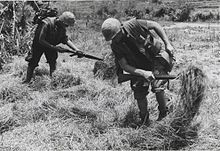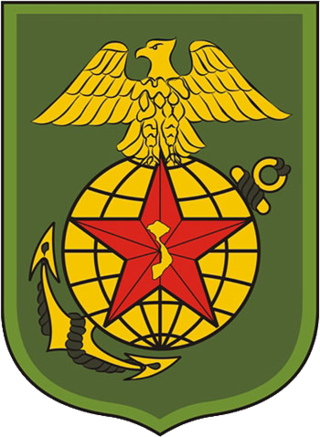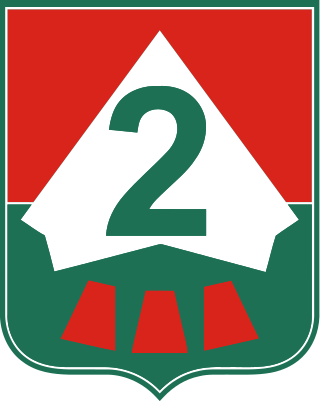Background
The objective was to clear out People's Army of Vietnam (PAVN) units from their base camps and infiltration routes in the hills and valleys of Quảng Nam Province, southwest of Da Nang, particularly Happy Valley and Charlie Ridge ( 15°56′10″N108°05′42″E / 15.936°N 108.095°E / 15.936; 108.095 ) 20–25 km southwest of Da Nang. [1] : 103 [2]
The Marines had previously scoured the area in Operation Mameluke Thrust and Operation Maui Peak both of which ended in October 1968. Defector and prisoner interrogations gave intelligence about a renewed buildup of PAVN forces in the area and one prisoner, a captain in the 141st Regiment, gave detailed intelligence on infiltration routes into the area. He revealed that the main infiltration route was from Ai Yen along Route 614 and into Happy Valley, while another branch followed the Song Con river south to An Dien 8 km northeast of Thường Ðức Camp and then along the Song Vu Gia river into Base Area 112 or Charlie Ridge. [1] : 103 As the Marines had recently neutralized Base Area 112 in Operation Taylor Common it was decided that the next operation would be to clear the hills west of Da Nang. [1] : 104
The terrain was expected to be a major challenge as Charlie Ridge was a steep and narrow mountain range with numerous gullies and ravines with thick undergrowth and dense overhead cover, while Happy Valley was covered by dense undergrowth, all of this would limit the effectiveness of supporting arms and make helicopter support more difficult. [1] : 104
On 21 March the 1st Battalion, 7th Marines began a 10 km march west along Route 4 from Firebase Rawhide to take Hill 52. On 24 March Company C secured Hill 52 and the Marines began construction of Firebase Mustang and on 30 March Battery K, 4th Battalion, 11th Marines was in position at Mustang. [1] : 105
Operation
After sunset on 30 March the 2nd Battalion, 7th Marines landed at Hill 10 establishing Firebase Stallion and they began moving west into the operational area, at the same time 3rd Battalion, 7th Marines landed on Hill 41 and also began moving west and by the following morning both battalions were in positions along the slopes of Charlie Ridge. [1] : 106
At 11:00 on 31 March HMM-165 helicopters landed the ARVN 2nd Battalion, 51st Regiment northeast of Thường Ðức Camp and the 3rd Battalion, 51st Regiment northwest of the camp. On 1 April the 3rd Battalion, 26th Marines and the 4.2in mortar battery from 1st Battalion, 13th Marines were landed at Landing Zone Robin overlooking Happy Valley. [1] : 106
With the forces in place the 2/7 Marines and 3/7 Marines advanced west searching Charlie Ridge while the 3/26 Marines and the ARVN battalions searched southeast and northeast. Movement was extremely difficult in the thick jungle and the forces soon restricted themselves to operating along the network of trails, establishing company base camps and then sending platoon radiating out to search the trail network. [1] : 106
On 1 April a reconnaissance team captured a PAVN sergeant from the 141st Regiment and Company K, 3/7 Marines captured a warrant officer from the 31st Regiment and they each revealed the location of their regimental base camps. Col. Robert L. Nichols decided to attack the base camp of the 141st Regiment near the summit of Hill 1166 and the 3/26 Marines was ordered to advance south up the ridgeline towards the Hill while 3/7 Marines advance from the east. By the afternoon of 7 April 3/26 Marines had secured Hill 1166 and 3/7 Marines had secured Hill 1062 nearby. [1] : 107 On the morning 8 April 3/26 Marines descended into the ravine containing the base camp engaging 20 PAVN soldiers as they attempted to escape to the southwest. The next day 3/26 Marines continued to search the camp area skirmishing with small groups of PAVN. On 11 April 2/7 Marines advanced on the 31st Regiment base camp on Hill 745 discovering over 200 structures. By 15 April the PAVN had abandoned their base areas. [1] : 108
1/7 Marines patrolled the south of the operational area along the Song Vu Gia carrying out ambushes of likely PAVN lines of communication between Charlie Ridge and the Arizona Territory to the south and on the night of 13 April ambushed a group of 30 PAVN as they crossed the river killing 14. [1] : 109
On 21 April 2/7 Marines and Battery H 3/11 Marines were withdrawn from the operation and replaced by an ARVN battalion on Firebase Buckskin on Hill 502. The remaining units participating in the operation were now assigned general areas of responsibility sweeping Happy Valley and Charlie Ridge encountering scattered groups of PAVN. [1] : 110
On the afternoon of 21 April intelligence indicated that a PAVN force was moving from the Arizona Territory north towards the Song Vu Gia and 1/7 Marines established ambush positions along the north bank of the river. After sunset small groups of PAVN were observed on the south bank of the river but the Marines held their fire and at 21:00 a large group of PAVN emerged from the bush on the south bank bring 17 small boats with them. When the PAVN boats started crossing the river the 1/7 Marines opened fire with recoilless rifles, 81mm mortars, machine-gun and rifle fire while pre-registered artillery engaged the PAVN remaining on the south bank. 57 PAVN dead were later counted floating in the river. At dawn on 22 April air strikes hit the south bank and at 09:30 Company B, 1/7 Marines boarded LVT-5s to cross the river and search the south bank finding a further 14 dead PAVN. [1] : 111–3
On 29 April the area of operations was extended south of the Song Vu Gia into the northern Arizona Territory and that night Companies B and D, 1/7 Marines crossed the river and established positions near the village of My Hoa. On the morning of 30 April the two companies advanced southeast and Company B on the right flank was engaged by a PAVN force, Company D then swung round to the northwest and both companies then began attacking southwest into a PAVN force estimated to be two companies strong. The fighting continued throughout the day and into 1 May and the 3rd Battalion, 1st Marines operating north of Go Noi Island to the northeast was sent by truck to assist the 1/7 Marines. On the morning of 2 May 3/1 Marines began advancing east and by midday had linked up with 1/7 Marines and that evening both battalions crossed north over the Song Vu Gia. The sweep of the northern Arizona Territory had killed 60 PAVN for the loss of 9 Marines. [1] : 113–4
On 2 May Companies K and L, 3/26 Marines and Battery C, 1/13 Marines were withdrawn from the operation. [1] : 110
From 6–12 May Company I, 3/7 Marines conducted a sweep of the Song Tan Thong river area west of Happy Valley with minimal results. [1] : 114
On 9 May 3/1 Marines left the operation. [1] : 114
On 21 May Company L, 3/7 Marines began a 5-day sweep of the Ken Valley with minimal results. [1] : 115
On 26 May after completing the destruction of the 31st Regiment base the ARVN 1st Battalion, 51st Regiment was withdrawn from the operation and on 29 May after destroying the remaining firebases the 3/7 Marines withdrew from the area. [1] : 115


















